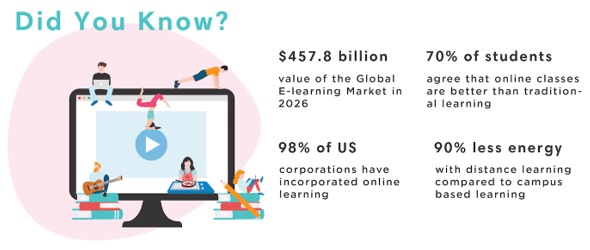The world is evolving at a rapid pace, and so does technology. Gone were those days when teachers and students rely on the traditional method of teaching and learning, it’s being replaced with the new way of virtual teaching and learning method.
Accordion to upskillwise.com, the value of the Global E-learning market is estimated to be 457.8 billion, because most of the students prefer online classes over traditional learning.

Source: https://upskillwise.com/online-learning-statistics/
This opens the door to huge opportunities for capable teachers to teach around the world, especially for those teachers who have pursued courses like 120-hour TEFL/TESOL in-class programs in Bangalore.
However, maintaining relevancy in this digital world is easier said than done for teachers, but there’s no need to worry because we have created this blog post, which contains top tips for creating the best virtual classroom for teaching English online.
Before jumping in to the topic, can we ask one question? Do you follow us on Social Media? We regularly share upgraded educational content, tips, feedback and more. Check us out by clicking the profiles here - Facebook / Twitter / LinkedIn / Pinterest / Instagram / YouTube
So, without any further delay, let’s get started.
Tips to Create a Best Possible Classroom Environment
1. Have A Good Background
To set the right professional tone and perfect distraction-free learning environment a good background is very essential for every teacher who’s teaching online. You can follow the below steps to create a good professional background.
- The first step in creating a good background is choosing the right location. A quiet, well-lit room with a neutral background is ideal. Your room should be quiet, and well-lit with a neutral background which is ideal for teaching. Make sure your background is not messy and cluttered which could divert the attention of your students.
- Once you find or create the right space for teaching it’s time to add some personal touch to your background. Adding colourful posters, charts, or even a whiteboard can create a more visually appealing environment for your students. You can also use a green screen or a software tool like ManyCam to create custom backgrounds that suit your teaching style as well.
2. Use of Different Props
As students of any age, their attention could get diverted easily to keep them hooked in your class or to demonstrate some of the concepts, props could prove to be a great way to make your virtual classroom more interactive and engaging.
Additionally, always remember to select props according to the student’s age and English proficiency level as well.
- During the time of teaching your young learners, you can use puppets, stuffed animals, and musical instruments are the best props you can use. It will help every student especially shy or specially-abled students to come out of their shells and they will have a fun experience during learning. Flashcards and whiteboards are also useful props for teaching new vocabulary and concepts.
- However, in the case of adult learners, you need to have a more professional approach. You can use props like maps of the world, travel pictures, newspapers, magazines, and books to make the learning experience easier for them. Additionally, it will also improve their reading comprehension, or with it you can also spark a conversation as well.
3. Creating a Reward System
There’s no better easy to keep your learners motivated to learn with more concentration and focus is by rewarding them. You can create a reward system that could help your learners to be engaged throughout the lessons which you will teach.
- Spinning Wheel
One popular reward system is the Spinning Wheel. This involves creating a cardboard wheel divided into sections, each with a different reward. You can spin the wheel to determine the reward for the student who has performed well.
- Pokémon Reward Chart
Another fun reward system is the Pokémon Reward Chart. This involves creating Poke balls with numbers on them and placing pictures of different Pokémon underneath. The student can choose a number and receive the corresponding reward.
- Ice-Cream Build Up
Another popular reward system is the Ice-Cream Build Up. This involves making two ice cream cones as well as several ice cream scoops. Every time a student does well, they get an ice cream scoop to put on their cone. The goal is to construct the largest ice cream cone possible.
4. Using TPR in Your Lessons
Total Physical Response (TPR) is a teaching method in which students physically respond to language input. This includes actions, gestures, and movements. TPR is especially beneficial for young learners, as it can aid in their comprehension and retention of new vocabulary.
- Simon Says
Simon Says is a popular TPR activity. This involves giving your students commands like "Simon says touch your nose." Students must only obey the command if you say "Simon says" first. This activity can help students learn about body parts, prepositions, and even verbs.
- Freeze Game
The Freeze Game is another fun TPR activity. This game involves playing music in which students have to dance and once the music stops, they need to freeze and hold that dancing pose when that music stops. This gaming activity is great for listening and comprehending skills.
5. Incorporating Technology
Technology can be a powerful tool in creating an engaging virtual classroom. There are many online platforms that offer interactive activities and games that can be used to reinforce learning. Some popular platforms include Kahoot, Quizlet, and Ed-Puzzle.
You can also use technology to create custom worksheets, slideshows, and videos. These resources can be used to supplement your lessons and provide additional practice for your students.
Another way to incorporate technology is to use a digital whiteboard. This allows you to draw, write, and annotate on the screen, making it easier to demonstrate concepts and explain difficult topics. Some popular digital whiteboards include Google Jamboard, Microsoft Whiteboard, and Explain Everything.
Become an Effective English Teacher Virtually
In today’s digital world, students prefer to learn through virtual methods rather than traditional ways of learning. This situation forced teachers to upskill themselves to stay relevant in the teaching profession.
Those teachers who have pursued courses like 120-hour TEFL/TESOL in-class program in Bangalore knows the skill to teach English online. However, our blog post contains some helpful tips which will help you to become an effective teacher online.
Additionally, remember to be flexible, patient, and enthusiastic, and you with your students will be sure to thrive in their own path.
Find the right course for you and try out the course. Call us at: 1800-212-6400. You can also mail us at act@asiancollegeofteachers.com.
Written By : Abhishek
